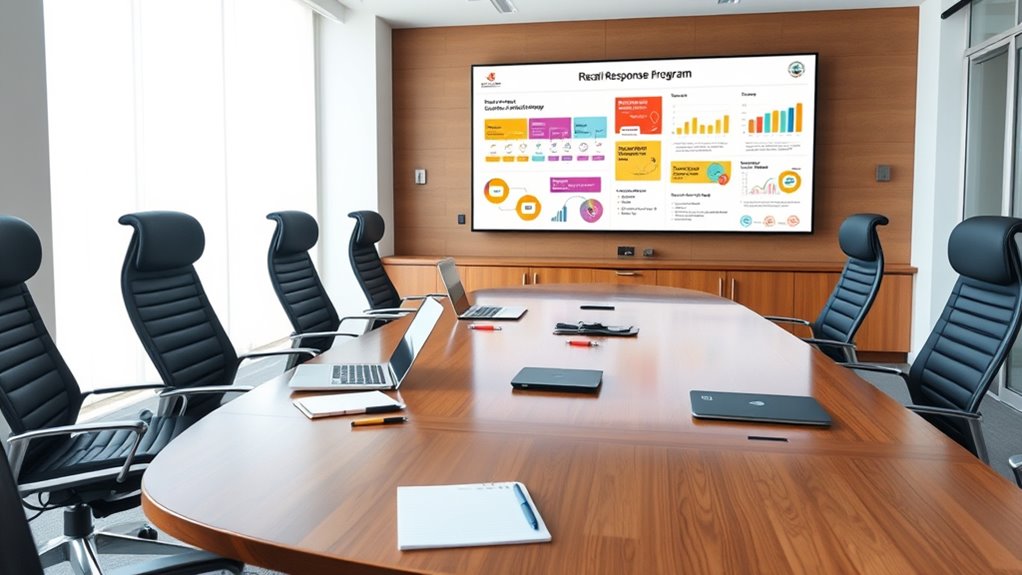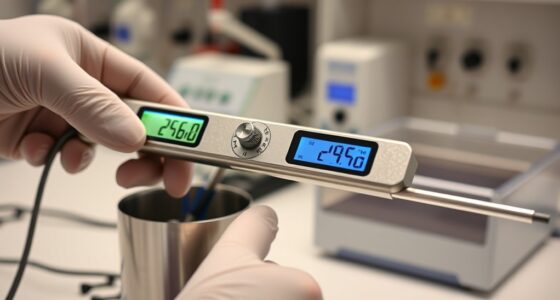To develop a recall response program, start by clearly identifying recall triggers through monitoring quality data and safety reports. Assign specific roles for coordination, communication, and logistics. Create contact strategies using multiple channels and prepare templates for quick responses. Implement thorough documentation, regularly conduct drills, and analyze past recalls for improvements. Incorporate technology like AI tools and data analytics to enhance efficiency. Keep refining your plan—exploring these steps further will help guarantee your readiness in crisis situations.
Key Takeaways
- Establish clear recall triggers, monitoring quality data, customer feedback, and regulatory updates regularly.
- Define roles and responsibilities, including a recall coordinator, communication lead, and logistics team.
- Develop comprehensive communication strategies with pre-prepared messaging for internal and external stakeholders.
- Implement training, simulation exercises, and continuous review to improve recall procedures and team readiness.
- Utilize technology like digital tracing, AI tools, and data analytics to enhance recall efficiency and compliance.
Assessing and Identifying Recall Triggers
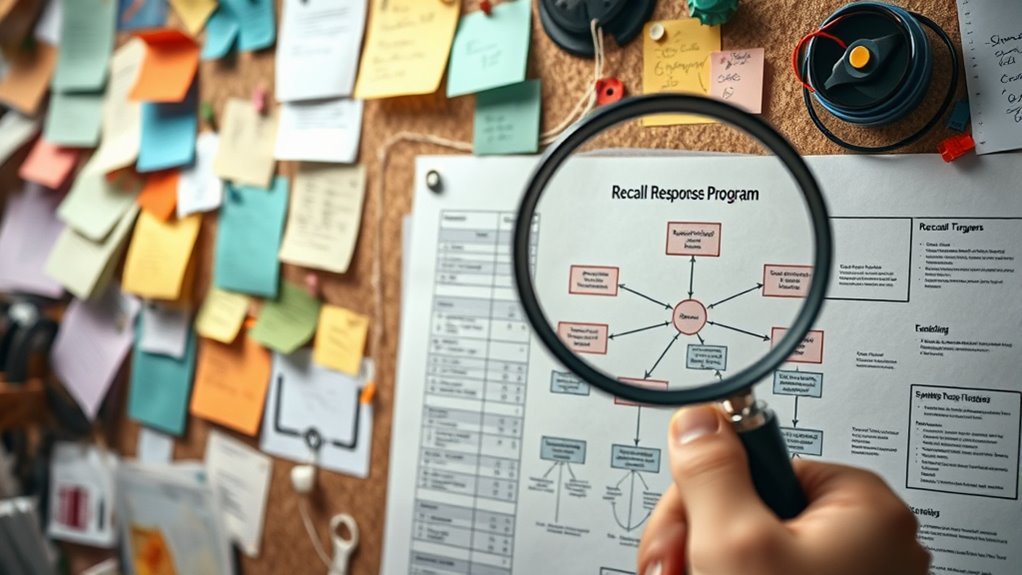
Evaluating and identifying recall triggers is a critical step in ensuring product safety and minimizing risks. You need to establish clear criteria that signal when a product might be unsafe or non-compliant. Regularly monitor quality control data, customer complaints, and safety reports to detect patterns indicating potential issues. Conduct thorough audits and inspections to spot manufacturing flaws or design vulnerabilities early. Stay updated on industry standards, regulations, and emerging safety concerns that could serve as triggers. By proactively recognizing these warning signs, you can act swiftly before problems escalate. Document all identified triggers and review them periodically to refine your detection process. Incorporating performance cookies can help analyze website interactions related to safety concerns, aiding in early detection. This proactive approach helps protect consumers and preserves your brand’s reputation.
Establishing Clear Roles and Responsibilities

To guarantee an effective recall response program, you must establish clear roles and responsibilities across your team. Doing so ensures everyone understands their specific duties, reducing confusion and delays. First, assign a recall coordinator responsible for overseeing the entire process. Second, designate a communication lead to handle internal and external messaging. Third, assign a quality assurance team to verify product issues and gather evidence. Fourth, appoint logistics personnel to manage product retrieval, storage, and disposal. Clearly defining these roles prevents overlaps and gaps, streamlining decision-making, and accelerates the response. When everyone knows their responsibilities, your team can act swiftly and efficiently, minimizing risks and protecting your brand reputation. Clear roles are the backbone of a resilient recall response plan. Additionally, understanding the ingredients and quality standards of the product can help in accurately identifying issues during a recall.
Developing Communication Strategies

How can you guarantee your recall communication is effective and timely? First, develop clear, concise messages that quickly inform affected parties about the issue, actions needed, and safety precautions. Use multiple channels—email, phone calls, social media, and press releases—to reach your audience promptly. Ensure your communication is consistent and transparent, avoiding confusion or misinformation. Design templates in advance to streamline messaging during a crisis. Assign specific team members to handle communication, and establish a rapid response system to approve and distribute information. Regularly test your communication plan through drills, so your team is prepared to deliver accurate updates swiftly. Effective communication minimizes panic, builds trust, and ensures everyone understands their role during a recall. Incorporating structured messaging strategies enhances clarity and reduces the risk of miscommunication during critical situations.
Implementing Documentation and Record-Keeping Procedures
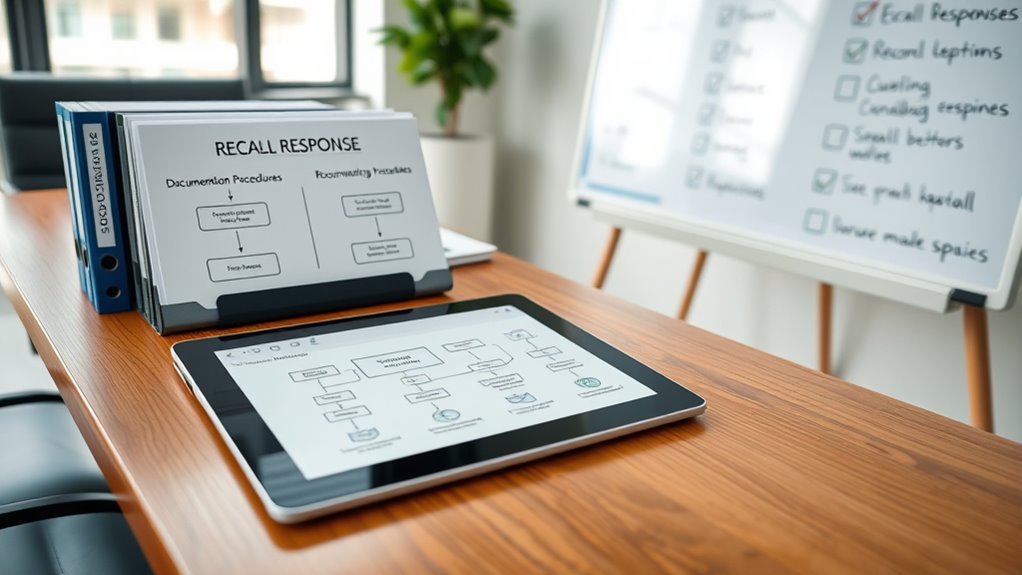
Effective documentation and record-keeping are vital components of a successful recall response. Clear records ensure you can track products, identify affected batches, and verify actions taken. To implement effective procedures, focus on these key areas:
- Maintain detailed records of all raw materials, production processes, and batch numbers.
- Track distribution data, including sales outlets and shipment dates.
- Document all communication with regulatory agencies and stakeholders.
- Keep logs of recall activities, such as notifications, product retrievals, and corrective actions.
- Ensuring proper record-keeping practices can significantly enhance the efficiency and accuracy of your recall efforts.
Conducting Training and Simulation Exercises
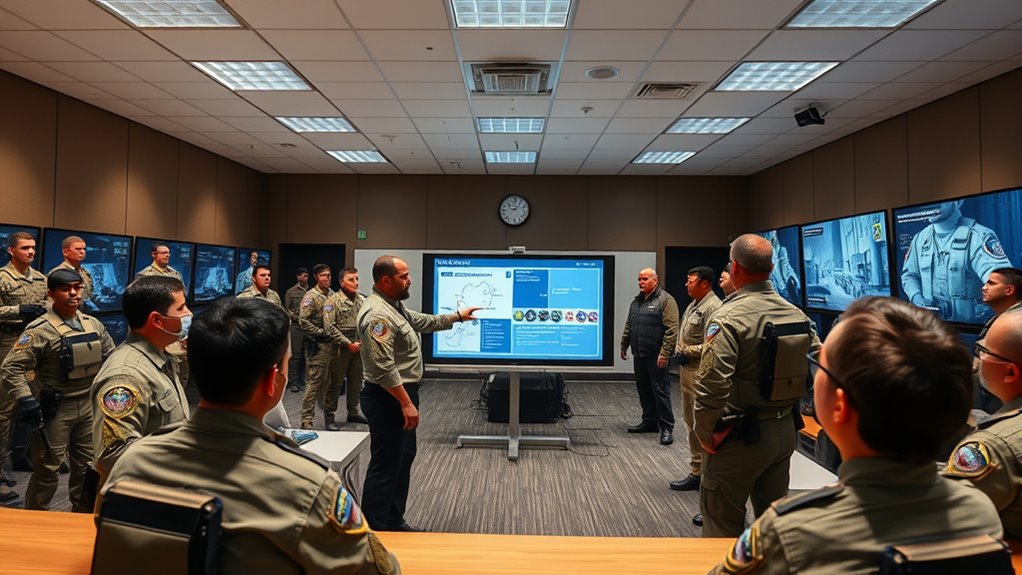
Conducting training and simulation exercises is essential to guarantee your team is prepared to respond swiftly and effectively during a recall. These exercises help identify gaps in your plan and ensure everyone understands their specific roles. You should schedule regular drills that mimic real recall scenarios, including communication protocols, product retrieval, and customer notification. During exercises, observe how your team performs, note areas for improvement, and adjust procedures accordingly. Incorporate different scenarios to test various aspects of your plan, such as supply chain disruptions or media inquiries. Consistent practice builds confidence and competence, reducing response time and errors during an actual recall. Regularly reviewing Glycolic Acid Benefits for Skin can also inform your team about product-specific considerations during a recall. Ultimately, these exercises strengthen your overall recall readiness and help protect your brand reputation and consumer safety.
Reviewing and Updating the Recall Plan Regularly
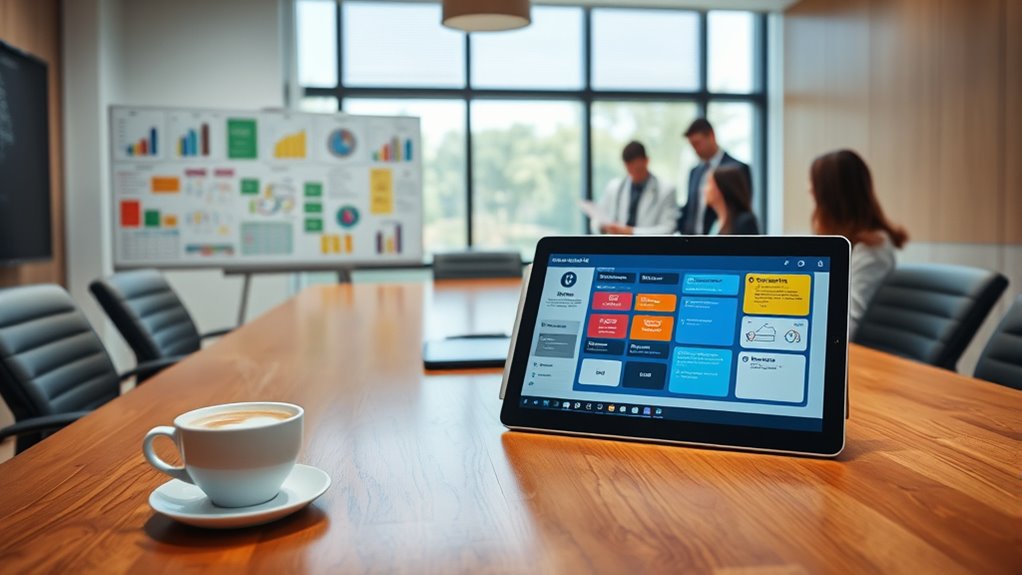
You need to review your recall plan regularly to guarantee it stays effective. Scheduling consistent updates helps you identify gaps and adapt to new regulations. Incorporating recent regulatory changes keeps your plan compliant and ready for any situation. Regularly consulting industry best practices and latest guidelines ensures your plan remains comprehensive and up-to-date.
Subheading 1: Schedule Regular Plan Reviews
Regularly reviewing and updating your recall plan guarantees it stays current and effective. You should set a schedule to evaluate your plan at regular intervals, such as quarterly or biannually. During each review, focus on these key areas:
- Confirm contact information for all stakeholders remains accurate.
- Test communication procedures with mock recalls or drills.
- Review recent product changes or updates that may impact the plan.
- Incorporate lessons learned from past recalls or issues.
- Ensure the plan aligns with current regulatory requirements and industry standards.
This proactive approach ensures your team stays prepared and your plan adapts to new challenges. Consistent reviews prevent outdated procedures, reduce response time, and strengthen your overall recall readiness. Regular updates are essential for maintaining confidence and compliance in your recall response efforts.
Subheading 2: Incorporate Regulatory Changes
Staying current with regulatory requirements is vital for maintaining an effective recall plan. Regulations evolve, and your plan must reflect these changes to assure compliance and efficiency. Regularly review updates from agencies like the FDA or OSHA, and incorporate their latest guidelines into your procedures. This proactive approach helps prevent compliance issues and streamlines your response during a recall. Use the table below to track regulatory updates and plan adjustments:
| Regulation/Guideline | Effective Date | Action Needed |
|---|---|---|
| FDA Food Safety Rule | Jan 2024 | Update recall procedures |
| OSHA Reporting Standards | Mar 2024 | Revise training protocols |
| ISO 22000 Standards | Jul 2024 | Enhance documentation |
Consistently updating your plan ensures you’re prepared for evolving requirements and maintains your recall readiness. Incorporating AI-powered tools can further enhance your ability to stay compliant by analyzing and tracking regulatory changes more efficiently.
Frequently Asked Questions
How Do I Prioritize Recalls Based on Risk Severity?
You should assess recalls by evaluating the potential health risk or safety hazard involved. Start by categorizing issues into severity levels—high, medium, or low—based on the impact on consumers. Focus on high-risk recalls first, as they pose the greatest danger. Use data from your quality checks, consumer complaints, and regulatory guidance to prioritize effectively, ensuring you address the most critical threats promptly and protect your customers.
What Legal Considerations Should Be Included in the Recall Plan?
When planning a recall, you should include legal considerations like compliance with regulations from agencies such as the FDA or CPSC, understanding liability issues, and guaranteeing transparent communication. You need to document your procedures, notify authorities promptly, and provide clear product information. Additionally, consider consumer rights, data privacy, and potential legal liabilities. By addressing these, you ensure your recall is legally sound and minimizes your company’s risk.
How Can Technology Improve Recall Response Efficiency?
Imagine your recall response like a well-oiled machine—technology keeps it running smoothly. You can use real-time tracking systems to locate affected products instantly, saving time and reducing risks. Automated communication tools keep customers informed, building trust. For example, one company cut recall time by 30% with RFID tags. Embracing technology streamlines your response, minimizes damage, and protects your brand’s reputation.
What Metrics Are Best for Measuring Recall Success?
When measuring recall success, you should track key metrics like response time, customer satisfaction, and the resolution rate. Response time shows how quickly you act, customer satisfaction reveals how well you handle concerns, and resolution rate indicates the effectiveness of your efforts. Regularly analyzing these metrics helps you identify areas for improvement, ensuring your recall response is efficient, effective, and keeps customers confident in your brand.
How Do I Manage Customer Complaints During a Recall?
When managing customer complaints during a recall, you should listen carefully and empathize with their concerns. Respond promptly and clearly, providing all necessary information about the recall process and safety measures. Offer solutions, such as refunds, replacements, or repairs, to build trust. Keep communication transparent and consistent, and document each complaint to identify recurring issues. This approach helps maintain customer loyalty and demonstrates your commitment to their safety.
Conclusion
By thoughtfully refining your recall response program, you create a foundation that gracefully navigates potential challenges. Regularly reviewing and updating your plan guarantees you stay prepared and adaptable, fostering confidence in your ability to address unforeseen concerns with poise. Embracing continuous improvement not only strengthens your system but also cultivates trust and resilience, allowing your organization to handle delicate situations with professionalism and care. In doing so, you uphold your commitment to safety and excellence.
